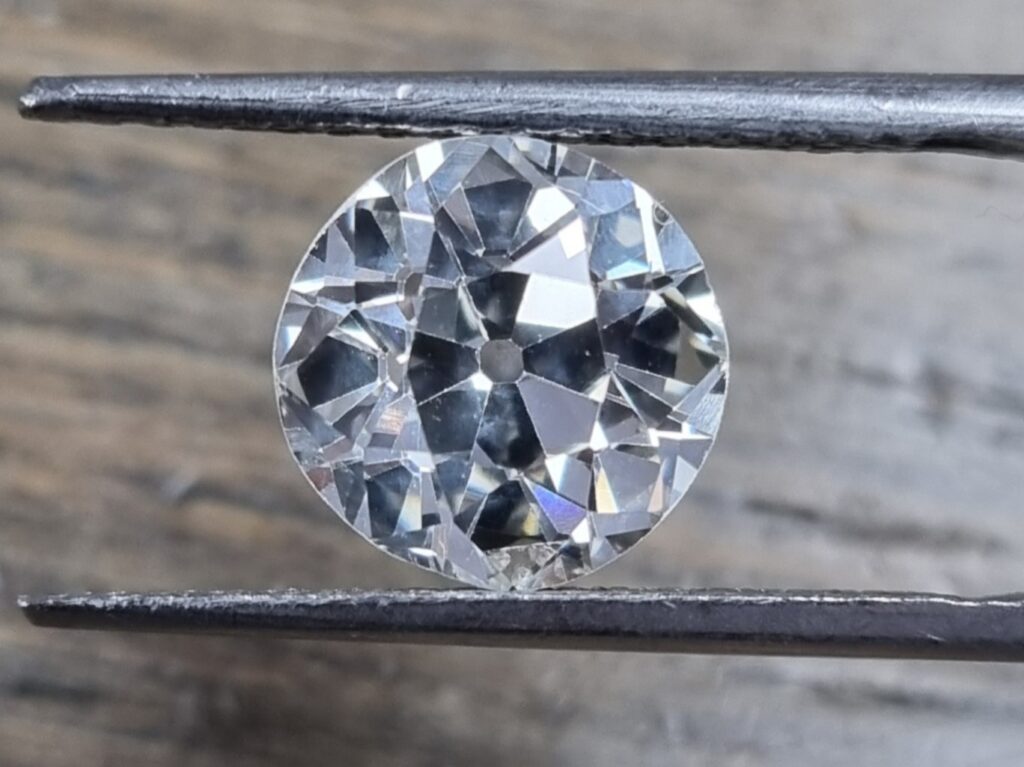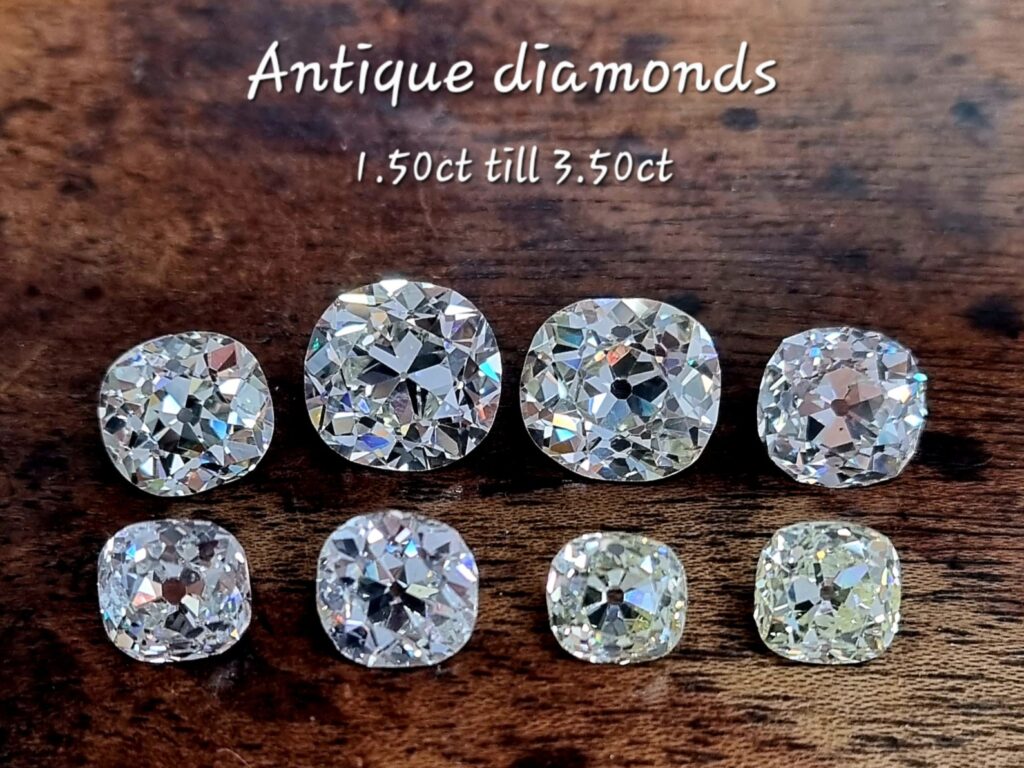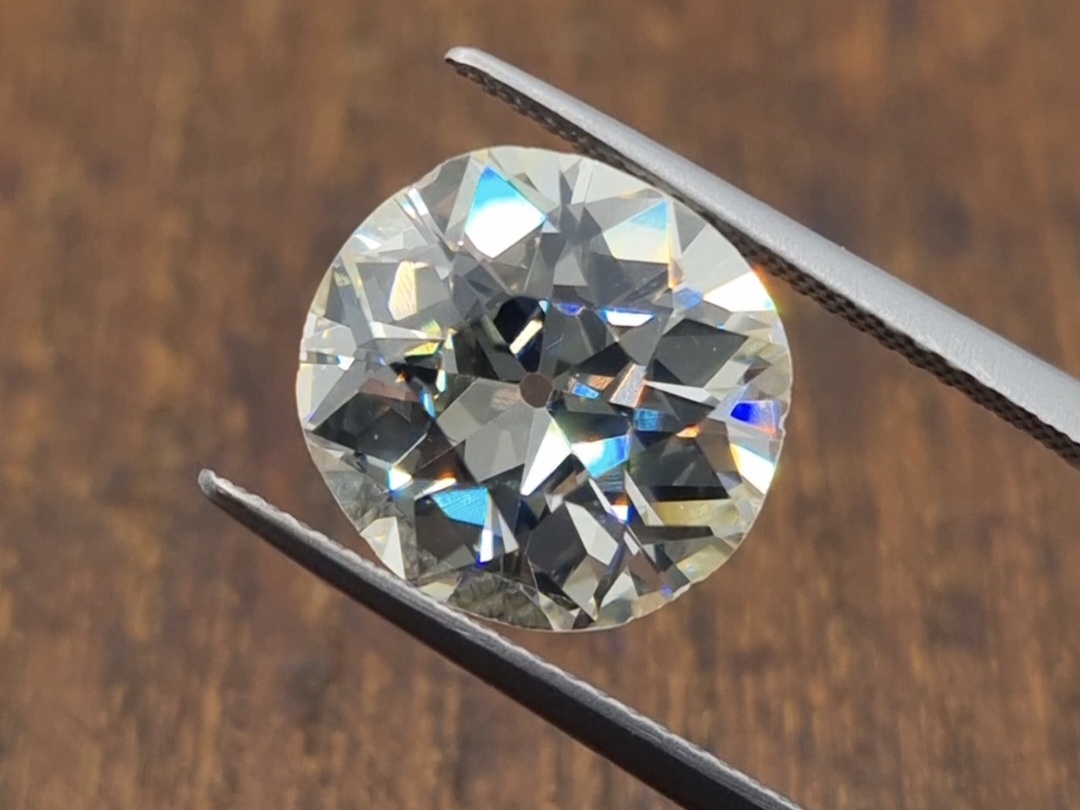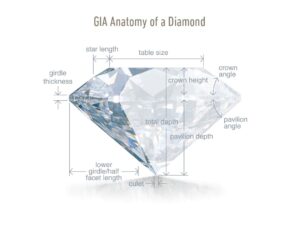This guide will explore how the 4 C’s of diamonds applies to antique diamonds, those unique and historical gems that have captivated collectors, jewelers and consumers alike. Antique diamonds have their own set of rules and allure, and understanding how the 4 C’s apply to them will provide you with a deep understanding and appreciation of these ancient gems
Before diving into the content of this article, I strongly recommend familiarizing yourself with some foundational topics in our “Diamond Basics” series. Specifically, the article on the “Anatomy of a Diamond” will provide you with essential terminology and insights into the various components of a diamond and their functions. Additionally, our piece on “Understanding the 4 C’s of Diamonds” offers a comprehensive guide to how the 4 C’s apply to modern-cut diamonds. These articles will equip you with the knowledge you need to fully appreciate the information presented here.
Table of Contents
The 4 C’s: Cut, Color, Clarity and Carat
Cut and Antique Diamonds
When discussing the 4 C’s of diamonds, it’s important to note that the cut in antique diamonds is quite different from that in modern ones. Modern diamonds are precisely cut using advanced machinery and mathematical formulas to optimize brilliance and sparkle. In contrast, antique diamonds were hand-cut with simple tools, making each stone unique.
Craftsmen of the past often used the natural shape of the rough diamond as their guide, rather than following strict geometric principles. This approach led to a distinct facet structure, often with larger facets, which gives antique diamonds their signature soft, romantic glow. This is in contrast to the sharp, intense brilliance found in modern cuts, which are often similar due to their mechanical precision.
It’s also worth mentioning that leading gemological organizations like the GIA do not provide cut grades for antique stones like Old Mine Cuts or Old European Cuts. This is because the modern standards for assessing “cut,” which primarily evaluate the proportions of a diamond, were developed long after these antique stones were created.

Color and Antique Diamonds
When discussing color and antique diamonds, it’s important to note that the standard color grading system often used for modern diamonds may not be the most applicable for antique stones. Antique diamonds frequently display a warm, inviting tone, commonly described as “candlelight.” This unique hue adds an extra layer of vintage allure that is highly desirable to many.
Interestingly, antique cuts like the Old Mine Cut often defy expectations in the color category. These stones can appear much whiter when viewed face-up, despite what their assigned color grade might suggest. This phenomenon is due to a combination of factors, including the diamond’s unique proportions, the stone’s depth, and the specific “old” material from which it was crafted.
Because of these unique attributes, you may find that you can comfortably choose an antique diamond with a lower color grade without compromising its face-up appearance of whiteness. The way these antique diamonds interact with light can make them appear whiter than their modern counterparts that have similar color grades. This offers greater flexibility when choosing an antique stone as a lower color grade will not necessarily have the same impact on the stone’s visual appeal as it would for a modern cut.
Therefore, when you’re considering the color grade of diamonds in the context of antique stones, it’s beneficial to understand how these unique characteristics can influence the diamond’s color and overall visual appeal. This nuanced approach to the color of antique stones provides a wider range of options for those captivated by the charm of antique gems.

Clarity and Antique Diamonds
When discussing the 4 C’s of diamonds, it’s important to recognize that the clarity aspect takes on a different dimension for antique diamonds compared to their modern counterparts. Modern diamonds are rigorously assessed for clarity, with any inclusions or blemishes often seen as detractors from their overall value.
In contrast, antique diamonds sometimes feature visible inclusions and often external blemishes, which are generally not viewed as flaws but rather as unique characteristics that add to the stone’s historical and aesthetic value. These vintage gems often come with a rich history, and their external imperfections can be attributed to the natural wear and tear over the years.
While modern technology allows for the possibility of recutting these diamonds to improve their clarity grade, doing so is generally discouraged. The reason is that these small, often microscopic, inclusions and blemishes can be considered the diamond’s patina, a testament to its age and hand-crafted origins. In essence, these imperfections usually do not detract from the stone’s visual appeal and can even add a layer of charm and uniqueness that is not found in modern cuts.

Carat Weight and Antique Diamonds
In the realm of the 4 C’s of diamonds, carat weight holds particular importance for antique diamonds. These vintage gems are rare to begin with, and finding larger specimens is even more uncommon. Many antique diamonds have been recut into modern shapes to meet contemporary standards, making the remaining original stones all the more valuable and sought-after.
The rarity of larger old cut diamonds significantly elevates their value. However, the allure of antique diamonds often extends beyond mere size to encompass the overall aesthetic and unique character of the stone. With fewer and fewer of these diamonds available due to recutting, each remaining antique diamond becomes a precious relic, its size and unique characteristics making it an increasingly rare find

Conclusion: Why Knowing the 4 C’s of Diamonds Matters
Understanding the 4 C’s of diamonds is key for evaluating both modern and antique diamonds, guiding you in assessing their quality and value.
The 4 C’s provide a structured approach to understanding what makes each diamond unique, whether it’s a modern round brilliant or an antique Old Mine Cut. By familiarizing yourself with these four key characteristics, you gain a deeper appreciation for the craftsmanship, history, and intrinsic qualities of the diamond you are considering.
However, it’s important to note that the 4 C’s serve as a general guide rather than a strict set of rules, especially when it comes to antique and non-round stones. Antique diamonds often possess unique features and characteristics that may not fit neatly into the modern grading scales, but these very traits contribute to their unique charm and historical significance.
So, whether you’re a collector, an investor, or simply someone who appreciates the beauty and history of diamonds, understanding the 4 C’s enriches your experience and informs your choices. It offers a lens through which to view these gems, not just as objects of beauty, but as symbols of craftsmanship and historical value.
Additional Resources
- “Diamonds: An Early History of the King of Gems” by Jack Ogden
- This book provides an in-depth look into the history of diamonds, including antique cuts.
- HRD Antwerp
- A leading authority in diamond certification, HRD Antwerp offers valuable insights into the grading and evaluation of antique diamonds.
- “The Nature of Diamonds” by George E. Harlow
- This book covers the geological aspects of diamonds and offers a historical perspective.
- “Diamond Cuts in Historic Jewelry – 1381 to 1910” by Herbert Tillander
- This book focuses specifically on the history of diamond cuts, making it a valuable resource for those interested in antique diamonds.
- “Gemstones of the World” by Walter Schumann
- While not exclusively about diamonds, this book offers a comprehensive look at gemstones, including their history and characteristics.




